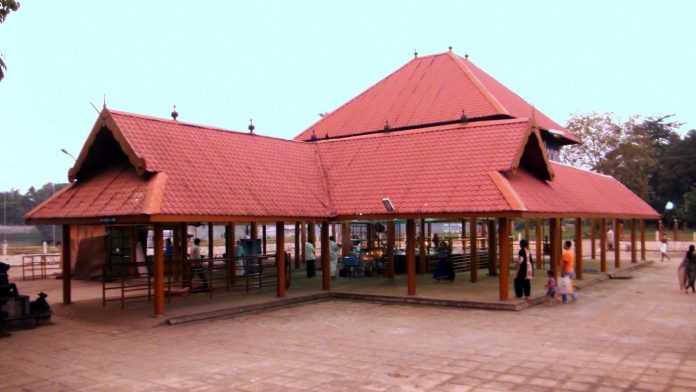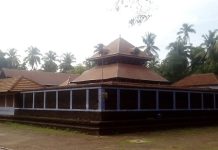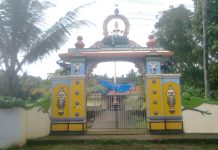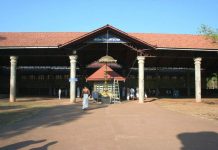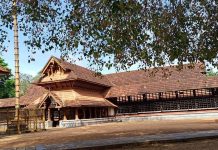As you travel from Ernakulam to Thrissur on the Highway, just after you leave the city limits of Ernakulam, and before you turn for the Airport, you will see two characteristic bridges marking the town of Aluva. The river Periyar flows near this town.
When you cross the first Marthanda Varma bridge, if you look to the right you can see a fork in the river. The Periyar river splits into two near Aluva railway bridge, and after splitting, one part is called Mangalapuzha. The Mahadeva Temple is situated at a distance of about a kilometre from the Marthanda Varma bridge, on the sand bank in between the Mangalapuzha and Periyar river. The Aluva Mahadeva Temple is managed by the Travancore Devaswom Board. During the monsoons, the water reaches till the roof top of the Temple and it is very unique to see such a phenomenon.
There are many legends associated with this temple. After installing the Lingam, Parasurama had built a temple here but was destroyed by a flood. Lord Shiva told him that no temple structure will exist at that place because He does not want a temple structure for protecting the Lingam.
Another legend goes like this. The Bhuthaganas of Lord Shiva worshipped the Lingam every night. They decided to construct a temple there. But Lord Shiva told them that they must complete the temple in a single night. Bhuthaganas agreed and started the construction. When the foundation was completed, Lord Vishnu came there, disguised as a cock and crowed to mislead the Bhuthaganas. The Bhuthaganas, fearing that dawn had approached, left the work unfinished. Apparently, Sri Rama, during his search for Sita, performed tharpana for Jadayu here.
As I mentioned earlier during the monsoon season the whole region gets flooded and the Shivalinga gets submerged in water. So the Namboodiris decided to construct a small temple on the banks of the river in order to perform poojas during monsoon season. This temple is called Bala Kshetram. It is a fact, that, though unfinished in nature, this temple has withstood many a flood and still is an enigma to architects. The Travancore Devaswom Board authorities did construct a temple structure here some years ago but the ‘Deva Prasnam’, conducted later, revealed that construction of a temple structure is against Lord Shiva’s wish.
The unique feature of Aluva Mahadeva Temple is that the Shivalinga is not enshrined in a Sreekovil. The Swayambhoo Shivalinga, supposedly installed by Lord Parasurama, and worshipped by Lord Sree Rama rises out of the sand banks of the Periyar river. For several years this Siva Lingam, did not have even a roof and it used to get submerged during the rainy season. Now it has a roof, but not the usual Sreekovil.
The Lingam faces east. There is a Nandi prathishta infront of the temple. There is only one pooja daily. From Makaram 1 (mid Jan) to Medam 1 (mid-May) only athazha pooja is performed and on other days only nivedyam is offered. Sivarathri in Kumbham (Feb-Mar), Utsavam in Meenam (Mar- Apr), Vavu Bali in Tulam (Oct- Nov) and Karkkidakam (Jul-Aug) are the festivals. Dhara and Rudrabhishekham are the main offerings.
The most important festival of Aluva temple is the Maha Sivarathri in Kumbham (February- March). There is no other place in Kerala where Sivarathri is celebrated on such a grand scale as in Aluva. The Sivarathri festival is a colourful celebration and devotees stay away the whole night in prayer and pay homage to their ancestors. The sand bank is extensive and the pilgrims run into several thousands.
On the night of Sivarathri, pilgrims keep awake and recite the puranas. There are shows, dances etc. meant for keeping the pilgrims awake throughout the night. In addition to the observance of Sivarthri rites, most of the pilgrims offer Bali (sacrifice) to their ancestors in the morning succeeding the holy
night. A dip in this river at the Brahmamuhurtham, after observing the rituals of Sivarathri is considered very sacred. Daily Ezhunnallippu of the deity atop a caparisoned elephant is conducted. The festival concludes with the Aarattu on the next day of Sivarathri.
On the day of vavu (no moon day) in Karkidakam (the last month of the Malayalam calendar which falls in July- August), Hindus gather on the riverbanks and beaches to offer Bali to the souls of departed ancestors. The bank of river Periyar in Aluva in Ernakulam district, popularly known as Aluva Manappuram, is significant in the observance of this Karkidaka Vavu Bali.
Next time you land at Kochi airport and travel to Ernakulam, look out for this temple close to Aluva. If you have time to spare, then you must visit also, just, be sure the is not flooded. By the way, do you know how the name Ernakulam originated? Well. The commercial capital of the state has two popular theories that claim stake in its name – one says that the city’s name is coined from the Tamil word Erayanarkulam, which means the abode of Lord Shiva. Another version supposes that the name was drawn from Malayalam words Ere-naal-Kulam, which literally translates to ‘Pond for a long time.


























